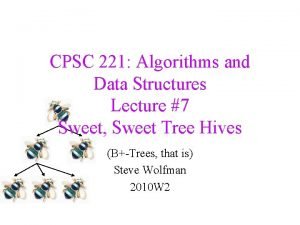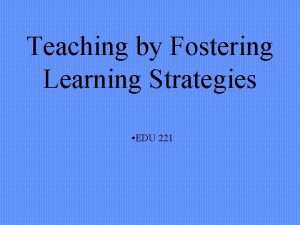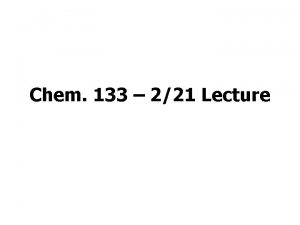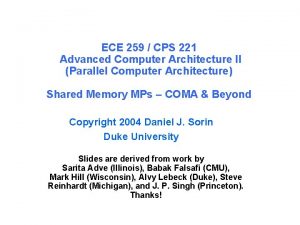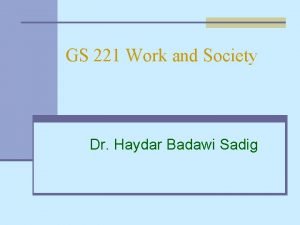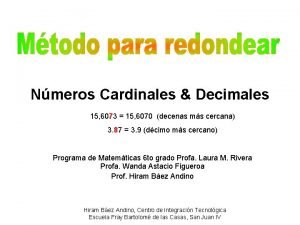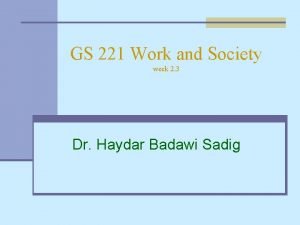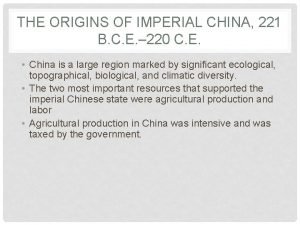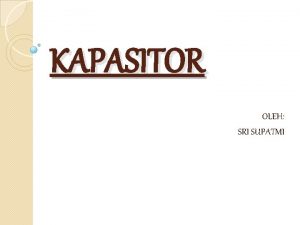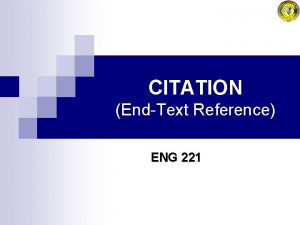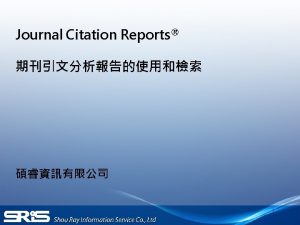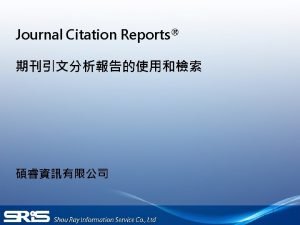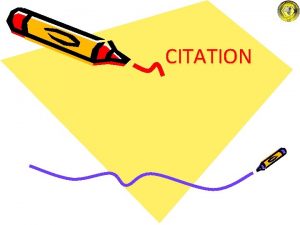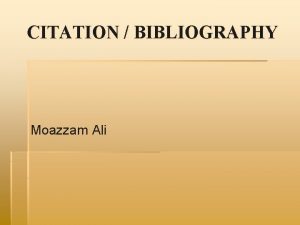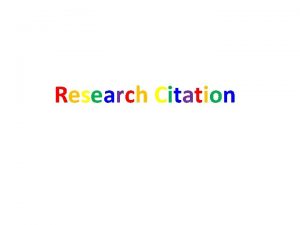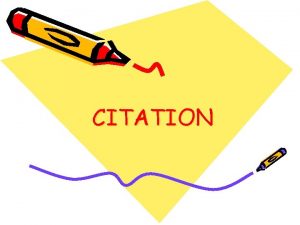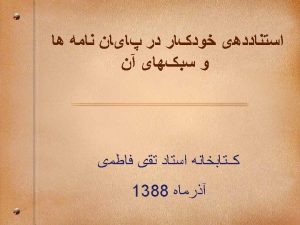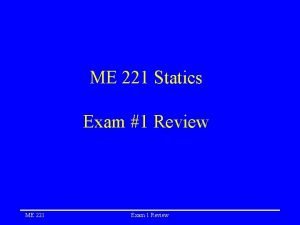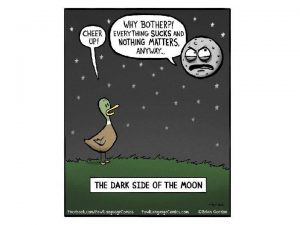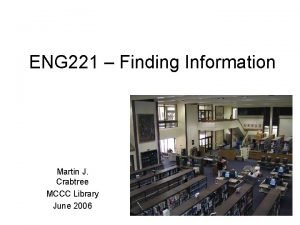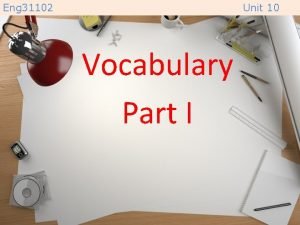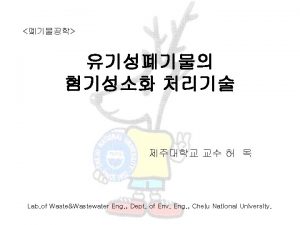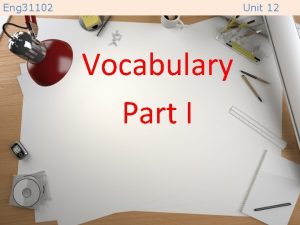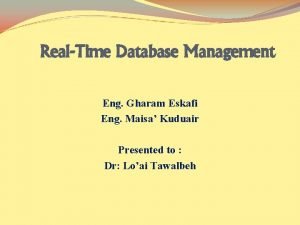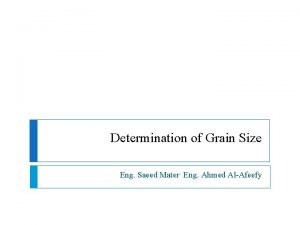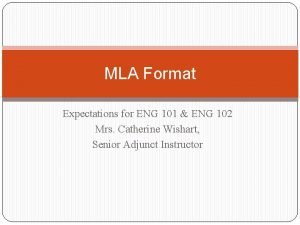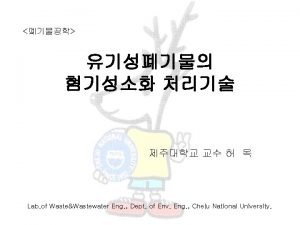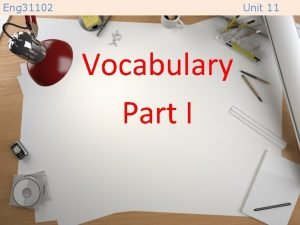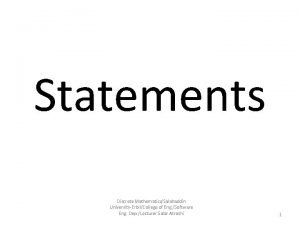CITATION ENG 221 What is citation Citation n























- Slides: 23

CITATION ENG 221

What is citation? • Citation (n. ) 1. A quotation from or reference to a book, paper, or author, esp. in a scholarly work

• Broadly, a citation is a reference to a published or unpublished source (not always the original source).

A "citation" is the way you tell your readers that certain material in your work came from another source. It also gives your readers the information necessary to find that source again, including: • information about the author • the title of the work • the name and location of the company that published your copy of the source • the date your copy was published • the page numbers of the material you are borrowing

Shortly; To show different points of view To support our ideas Why do we cite? To be more credible in giving information

Direct Quotation CITATION Borrowing others’ ideas by indicating the source Paraphrasing Summary

How do we cite references? • In-text reference or In-text citation • End-text reference or End-text citation (These subjects will be focused on in detail. )

REMEMBER: • While you integrate sources into your essay, it should be kept in mind to give both in-text and end-text references whenever you use others’ ideas and/or research.

What information should be cited? • • All direct quotations All paraphrases All summaries All facts and statistics that are not common knowledge • All translations

Analyze different ways of giving in-text reference in the sentences below. • Several rivers aside from the Thames once intersected London, although those rivers have since been covered over by development (Clayton, 2000, p. 28). • Anthony Clayton points out that several rivers aside from the Thames once intersected London, although those rivers have since been covered over by development (2000, p. 28). Also; • Clayton (2000) points out that several rivers aside from the Thames once intersected London, although those rivers have since been covered over by development (p. 28).

BRIEF GUIDELINES for GIVING IN-TEXT REFERENCE When you refer to a text with two writers, if the writers’ names are in parantheses, put an ampersand (&) between the two. However, if the writers’ names are outside the parantheses, use “and” in between.

Work by two authors named in the text • Rosdahl and Weise point out that the unemployed of Denmark have had the right to request job related activities such as training or publicly supported work, but that right has recently become an obligation (2001, p. 160). Also; • Rosdahl and Weise (2001) point out that the unemployed of Denmark have had the right to request job related activities such as training or publicly supported work, but that right has recently become an obligation (p. 160).

Work by two authors • The unemployed of Denmark have had the right to request job related activities such as training or publicly supported work, but that right has recently become an obligation (Rosdahl & Weise, 2001, p. 160).

Work by three or more authors • Cite all authors the first time the reference occurs; Ø in subsequent citations, include only the last name of the first author followed by 'et al. ' EXAMPLE: The first time Kahneman, Knetsch, and Thaler (1991) found that. . . The second time (or other times) Kahneman et al. (1991) found that. . . *et al. = Latin; “and others”

BRIEF GUIDELINES for GIVING IN-TEXT REFERENCE When you refer to source with three or more writers, you do not need to list all the surnames each time you cite the source. The first time you cite the source, list all the surnames putting an ampersand (&) before the last one. From then onwards, write only the surname of the first writer and “et al. ” which means “the others” in Latin.

BRIEF GUIDELINES for GIVING IN-TEXT REFERENCE • If the source you use has no author but is the work of an organization, you can give the name of the organization instead of the writer’s surname. (UNESCO, 1999, para. 4) • If the source you use has no author, give the title in quotation marks. (“An effective Leader, ” 2000, para. 7)

BRIEF GUIDELINES for GIVING IN-TEXT REFERENCE • If the information you want to borrow appears as a borrowed source in the source you have at hand, you should refer to both writers using “as cited in”. EXAMPLE: According to Viscount Slim, willpower and firmness, which are elements of determination, are the most critical characteristics for a leader (as cited in Hughes et al. , 2006, p. 15).

BRIEF GUIDELINES for GIVING IN-TEXT REFERENCE • If there is no date of publication, put “n. d. ” in the place of year of publication. ( Jackson, n. d. , para. 5). • If the information is on a single page, put “p. ” before the page number. EXAMPLE: Lewis (1967) points out that following his victory in the Turkish War of Independence, there were many distractions, which at that time might have dissuaded Mustafa Kemal, a war-hero (p. 254).

BRIEF GUIDELINES for GIVING IN-TEXT REFERENCE • If the information is on more than a single page, put “pp. ” and “-” between the page numbers. EXAMPLE: Kinross (1965, pp. 94 -95) points out that knowing the patriotic fighting spirit of the Turks, Mustafa Kemal knew how to arouse. . .

BRIEF GUIDELINES for GIVING IN-TEXT REFERENCE • If there is no page number, indicate the paragraph number with either “para. ” or the symbol “ ” EXAMPLE: In his article “Atatürk in His Lifetime and Today”, Mango (2000) explains, as one of the Turkish biographers put it, the basic ideas, the new ideas came from Atatürk, their implementation he left to others (para. 3). OR In his article “Atatürk in His Lifetime and Today”, Mango (2000) explains, as one of the Turkish biographers put it, the basic ideas, the new ideas came from Atatürk, their implementation he left to others ( 3)

Indirect quotations v Use this form to cite a quotation that was found in another (not the original) source. For example; • John Evelyn described London's churchyards as being filled with bodies "one above the other, to the very top of the walls, and some above the walls" (qtd. in Clayton, p. 14).

Electronic and Multimedia Sources v Electronic sources are cited in the typical author-page number style with one difference: when an Internet site does not have page numbers, offer other location information such as screen, section (sec. ), paragraph (para. ), track, or time frame (minute). For example: • Because of Greece's physical characteristics-its jagged coast made almost all settlements within 40 miles of the sea-the ancient Greeks relied on the sea for most long-distance traveling (Martin, 2002, sec. 2. 4).

Although it is beneficial to know the basics of referencing. . . You do not need to remember all these. Always check by writing APA referencing guide on www. google. com
 Funksiyaning ekstremumlari
Funksiyaning ekstremumlari Ee 221
Ee 221 Cpsc 221
Cpsc 221 Cpsc 221 ubc
Cpsc 221 ubc Csce 221 tamu syllabus
Csce 221 tamu syllabus Einstein flow cytometry
Einstein flow cytometry 866-221-0269
866-221-0269 Edu-221
Edu-221 Cpit221
Cpit221 Fisher effect equation
Fisher effect equation Sp 221
Sp 221 133 221
133 221 Ancient chinese religion
Ancient chinese religion Lagr 221
Lagr 221 Csce 221 tamu syllabus
Csce 221 tamu syllabus Rotational statics
Rotational statics Cps 221
Cps 221 Gs-221
Gs-221 Una decena de millar mas tres centesimos
Una decena de millar mas tres centesimos Cse 221
Cse 221 Emmett school district 221
Emmett school district 221 Gs-221
Gs-221 221 bc
221 bc Kapasitor polar dan nonpolar
Kapasitor polar dan nonpolar


